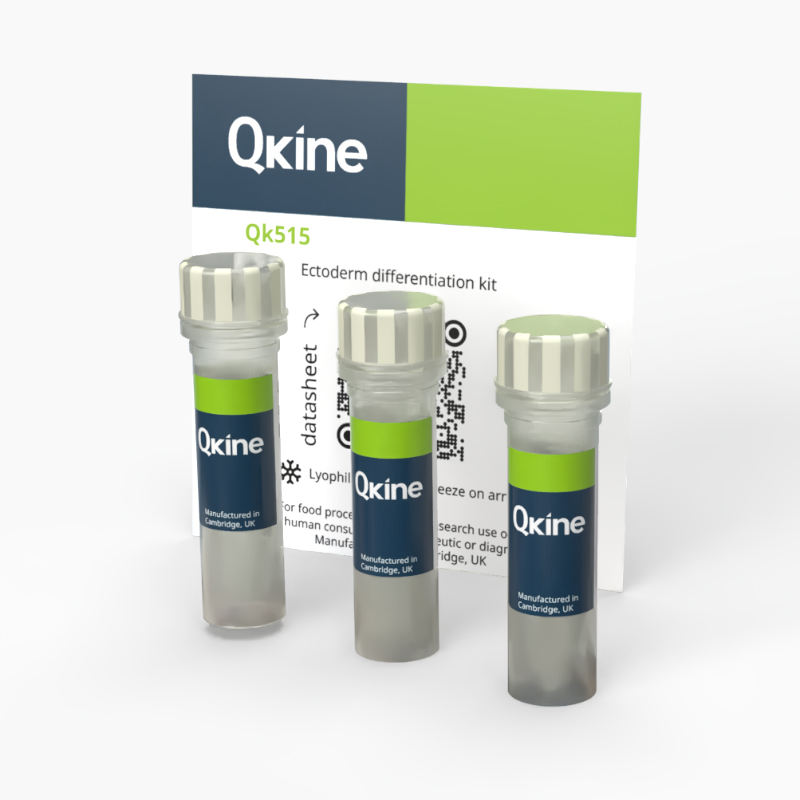 Ectoderm differentiation kit (Qk515)
Ectoderm differentiation kit (Qk515)Ectoderm differentiation kit (Qk515)
Original price was: £455.00.£305.00Current price is: £305.00.
For validating the ability of induced pluripotent stem cell (iPSC) lines to differentiate into the ectoderm lineage.
The ectoderm differentiation kit is designed to validate the differentiation potential of both newly derived and established iPSC lines. This kit enables the evaluation of the ability of iPSCs to differentiate into the ectoderm linage, one of the three primary germ layers responsible for giving rise to the nervous system, skin, and sensory organs.
The kit includes carefully optimized growth factors and extracellular matrix required to efficiently guide iPSCs toward the ectoderm lineage. It serves as both an endpoint assay, confirming pluripotency and lineage commitment, and a platform for generating ectoderm-derived cells for further downstream applications.
Each kit is sufficient for differentiation of 8x 96 well plates.
In stock
Orders are typically shipped same or next day (except Friday).
Easy world-wide ordering, direct or through our distributors.
Original price was: £455.00.£305.00Current price is: £305.00.
Buy online with secure credit card or purchase order. For any questions, please email orders@qkine.com
Summary:
>98%, by SDS-PAGE quantitative densitometry
Animal origin-free (AOF) and carrier protein-free
Expressed in E. coli
Bioactivity Guaranteed
Manufactured in our Cambridge, UK laboratories
Lyophilized
- See reconstitution instructions for individual kit components
Featured applications:
Differentiation of iPSC into ectoderm

Human noggin – Qk034 – 25 µg
Noggin is used in the culture of intestinal, pancreatic, lung and tumor-derived organoids and the maintenance of undifferentiated embryonic stem cells (ESC) and for stem cell differentiation into neural and microglial lineages.
Human FGF2-G3 (154 aa) – Qk053 – 50 µg
A thermostable engineered form of human FGF-2. Human FGF2-G3 154 aa is the 154 aa mature domain of FGF-2. The functional half-life has increased from <10 h (wild-type) to >7 days (FGF2-G3).
Human vitronectin – Qk120 – 500 µg
Provides a defined environment that supports the maintenance of pluripotency and is suitable for feeder-free culture, expansion, differentiation, and reprogramming of stem cells.
Further quality assays
Mass spectrometry: single species with expected mass
Recovery from stock vial: >95%
Endotoxin: <0.005 EU/μg protein (below level of detection)
We are a company founded and run by scientists to provide a service and support innovation in stem cell biology and regenerative medicine. All our products are exceptionally high purity, with complete characterisation and bioactivity analysis on every lot.
Protein background
Human induced pluripotent stem cells (iPSCs) are an in vitro model that represent a pivotal breakthrough in regenerative medicine and cellular biology. iPSCs are generated by reprogramming adult somatic cells to a pluripotent state through the introduction of specific transcription factors. Reprogramming iPSCs grants these cells the ability to differentiate into any cell type of the three germ layers: ectoderm, mesoderm, and endoderm. This provides unparalleled potential for disease modeling, drug discovery, and cell-based therapies, all without the ethical concerns associated with using embryonic stem cells [1].
Differentiating iPSCs into ectoderm lineage is particularly significant, given the ectoderm’s role in generating the central and peripheral nervous systems, sensory organs, and skin [2]. Differentiating iPSCs into neuroectodermal cells, followed by further differentiating into ectodermal lineages, is critical for studying neurodevelopmental processes, modeling neurological disorders, and developing potential therapies for conditions impacting the nervous system and skin.
The differentiation of iPSCs into neuroectodermal cells typically involves mimicking the stages of embryonic development in vitro. During early embryogenesis, the formation of neuroectoderm is initiated by inhibiting several signaling pathways, such as the TGF-β pathway using small molecule inhibitors like SB431542, and the bone morphogenetic protein (BMP) pathway using BMP inhibitors like noggin, which mimics the natural inhibition of BMPs that occurs during neural plate formation [3].
The successful differentiation of iPSCs into neuroectodermal cells is not without challenges. Due to variability within iPSC lines, differentiation efficiencies, and the potential for incomplete or mixed lineage differentiation are significant hurdles that researchers continue to address. The success can be evaluated by investigating the expression of markers such as SRY-box transcription factor 1 (SOX1) and SRY-box transcription factor 2 (SOX2) [4].
Additional resources
Our products are for research use only and not for diagnostic or therapeutic use. Products are not for resale.
For use in manufacturing of cellular or gene therapy products. Not intended for in vivo applications.

Receive an Amazon gift voucher when you leave us a review.
£25, $30 or €30 for reviews with an image and £10, $15 or €15 for reviews without an image
